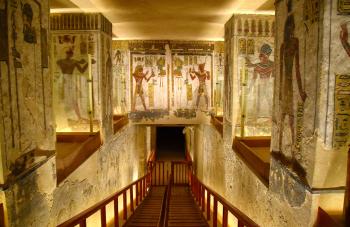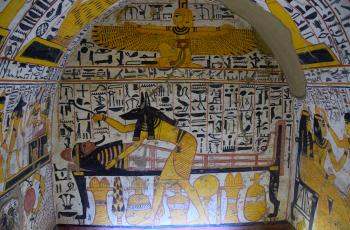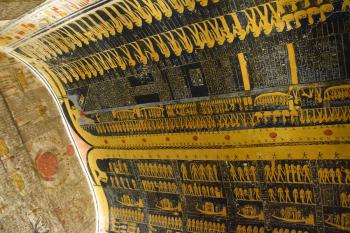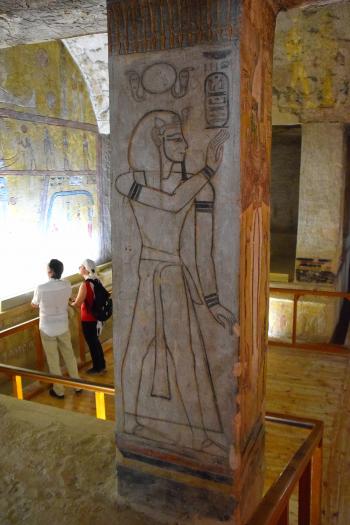A guided, solo trip to Egypt offers exceptional views inside the tombs of Luxor’s West Bank
This article appears on page 6 of the April 2019 issue.
After a visit to Egypt some years ago, I developed a particular interest in the tombs of the pharaohs and their queens.
Inspired by The Great Courses lectures by Professor Bob Brier, the "History of Ancient Egypt" and "Decoding the Secrets of Egyptian Heiroglyphs," I booked a solo trip to Egypt (Feb. 22-March 2, 2018) with Museum Tours (Littleton, CO; 888/932-2230, www.museumtours.com).
The goal of this trip was to see every single tomb in the West Bank of Luxor (ancient Thebes). More particularly, I planned to see every single tomb of the pharaohs, the queens, the nobles and the supervisors.
Making plans
Except for my international flights, William Petty, PhD, president of Museum Tours, arranged everything for me — guide, driver, hotel and airport transfers. Dr. Petty could not have been more accommodating and flexible.
He is an Egyptologist in his own right and has written several useful and interesting books on the subject, which he was kind enough to send me gratis.
Dr. Petty is in constant contact with operators on the ground in Egypt, and he was able to tell me instantly which tombs were open and which ones were closed. I had only one week in the country, but Dr. Petty sent me an itinerary that would enable me to achieve my goal of seeing all the open tombs and still have time left over to see all of the other significant monuments and museums in and around Luxor.
My trip was astonishingly inexpensive. The total cost of the land package (including my hotel and internal flights) was $3,290, and it was, hands down, the best value for money I have ever had on a trip.
I used EGYPTAIR as my international air carrier as they had the best flight times and were much less expensive than any other airline that I found. (My round-trip international flights cost $850 from New York's JFK airport.)
The security for my flight from New York was the tightest and most elaborate I have ever experienced anywhere in the world and came complete with several uniformed policemen with dogs plus seemingly endless bag and document checks. Travelers would be well advised to arrive at the airport earlier than the three hours that is typically recommended.
My flight left on time at 6:30 p.m. It was very pleasant, and we arrived in Cairo at 12:05 p.m. the following day.
Americans are required to purchase a visa to visit Egypt, and it can be obtained on arrival at the Cairo International Airport for $25, which must be paid in cash in US dollars.
At my arrival gate in the modern and rather charming Cairo International Airport (its control tower is designed to look like a lotus flower, one of the key symbols of ancient Egypt), I was met by a representative from the ground operator, who helped me retrieve my suitcase, obtain my visa and get through Immigration and security for my in-country flight to Luxor. (EgyptAir has several flights a day from Cairo to Luxor, so even if you miss your connection, you needn't worry.)
Luxor at last
I was met at the modern airport in Luxor by my wonderful expert guide, Mamdoueh, and driver, Hani, who would be with me for the entire trip. The trip from the airport to the hotel (on excellent roads) took about 20 minutes.
I had specifically requested a room at the Old Winter Palace Hotel (now known as the Sofitel Winter Palace Hotel), the late-19th-century grande dame of Luxor hotels and host to notables the world over. In better economic times, the hotel charged $450 and up per night for a room. Today, rooms are available at bargain-basement rates (less than $100).
All rooms are luxuriously furnished. Nile-facing rooms are most in demand, but garden-facing rooms are quieter, and the garden, replete with tall palm trees and much greenery plus a huge swimming pool, is absolutely lovely. Most rooms (including mine) have 15-foot ceilings, are very large and have balconies and generous bathrooms.
The Sofitel Winter Palace Hotel has two restaurants; one is "casual" and the other, 1886 Restaurant, is more formal. Dining at 1886 Restaurant was exquisite, with perfect service and excellent food — all for the price of around $10 (without wine). You simply cannot do better than that!
While the hotel's exterior paint could use some sprucing up and the touristy shops on its grounds should probably be avoided, this is truly the place to stay if you want real luxury in Luxor's East Bank. Another benefit is that it's only a 3-minute walk from the hotel to the adorable little ferryboats that whisk you to the West Bank in 10 minutes. It's also an easy 5- to 10-minute walk to the fabulous Luxor Temple, which dates to circa 1400 BC.
For those looking for a completely different hotel experience, I can also recommend the Marsam Hotel, the oldest in the West Bank. It is small (37 rooms) and quaint, has great food and a wonderful little gift shop offering Egyptian-made goods and is where many Egyptologists hang out. I went there for lunch a few times, and at every visit I saw researchers, their laptops open, discussing the latest excavations.
While I am not a great fan of Egyptian food, I can recommend Africa Restaurant, located in the West Bank approximately one block from the Nile, with a lovely view of the river and the East Bank of Luxor if you're seated on the balcony.
On to the tombs
The Ministry of State for Antiquities (MSA) is in charge of all antiquities in Egypt, including the tombs in the West Bank of Luxor. Because the MSA can open or close tombs at any time, and because the main goal of my trip was to see the tomb of Nefertari (Great Wife of Ramesses the Great), considered to be the most spectacular of all the tombs, and the tomb of Pharaoh Seti I, considered by many to be the grandest of the pharaohs' tombs, I asked Mamdoueh to be sure I saw those two tombs on my very first day.
I spent that first morning in the Valley of the Queens, seeing the royal tombs of Khaemwaset (QV44, fantastic), Queen Tyti (QV52, less interesting) and Amunherkhepshef (son of Ramesses III, QV55, a large and beautiful tomb).
Nefertari's tomb (QV66) was the last of the day, because at the time I arrived, the tomb was being visited by a Saudi princess. When I finally entered Nefertari's tomb, I immediately understood why it is considered to be the pièce de résistance.
After an intensive conservation effort (1986-1992), the tomb was briefly opened to the public in 1995 after considerable debate about the risk, but it was closed again to the general public in 2006 to preserve the delicate wall paintings from moisture damage. It was recently opened again to a limited number of visitors per day.
Surprisingly, I was the only visitor inside Nefertari's tomb at the time, so I was allowed to stay for half an hour rather than the usual 10 minutes. Not only that, but the cost was a pittance (EGP1,000, or $57), considering that not that long ago, the price of admission had been in the thousands of dollars.
What I saw when I entered Nefertari's tomb were bright images that looked as if they had been painted yesterday, although the conservationists had applied no new paint to the images whatsoever. There is no way to really put into words the magnificence of this unique tomb.
The state of preservation was phenomenal, the aesthetics, nonpareil, and the placement of the painted carvings in the architectural spaces was extremely thoughtful.
Throughout this tomb, even though the artists employed the typical method of stylizing the human figures, Nefertari's human beauty shines through, no doubt enhanced by her revealing, veil-like white robe and golden vulture headdress. In one gorgeous image of Nefertari, she shows off her wrist, which is decorated with a tattoo!
Ramesses II was besotted with his "Great Wife," and she is referred to frequently as "The Most Beautiful of All" and "The One For Whom The Sun Does Shine" (among her many epithets). Although Ramesses II had eight wives, only Nefertari was honored with a tomb that is clearly the most extravagant of all the tombs of ancient Egypt.
Valley of the Kings
From the Valley of the Queens, we drove a short distance to the Valley of the Kings, arriving in the late morning. The entrance building had an interesting "transparent" 3-D depiction of the position of the various tombs underground.
Upon exiting the building, I took a golf-cart-type train from the visitor center to the site of the pharaohs' tombs. There were tourists at the tombs, but the area could hardly be called crowded.
My first stop was the tomb of Ramesses IV (KV2). This tomb is not to be missed. It contains a huge amount of wall space devoted to the Book of the Dead and the Book of the Gates, all of which are carved beautifully into the plaster and painted in bright colors. It also features some 3rd- and 4th-century Coptic graffiti and a classic "master scene" at the entrance depicting the pharaoh worshiping the all-important god Ra-Horakhty.
The depictions on the walls — of snakes swallowing snakes, a huge variety of deities, the pharaoh's enemies and so much more — were spectacular.
The tomb of Ramesses IX (KV6), a 344-foot-long behemoth very close by, was even better, with an unusual depiction of a tipped-on-his-heels pharaoh with an arm raised over his head and another of the pharaoh on tiptoe, holding a snake. There are also depictions of baboons, the goddess Nut swallowing the sun and uraeuses (protective cobras that figure prominently in Egyptian mythology) with human arms reaching up in supplication.
The next stop was the tomb of Rameses III (KV11), the so-called "Harp Tomb" because of two depictions of people playing huge, harp-shaped instruments. This tomb was reopened just a few months before my visit and should be on everyone's itinerary.
Around 1 p.m. we started to head over to the West Valley because word had gotten around that Dr. Zahi Hawass, the former head of Egypt's Supreme Council of Antiquities (until the 2011 revolution) and probably the most ubiquitous and recognizable personality on television shows about ancient Egypt, was there. (He was overseeing an excavation in the West Valley.) Sure enough, before we had driven five minutes, we spotted Dr. Hawass' limousine headed our way.
Mamdoueh told me to "jump out and run over there and say hello," which I immediately agreed to do. Happily, Dr. Hawass wasn't put off by this crazy lady waving her arms at him. When he rolled down his window, his first words to me were "Get in the car."
This time I hesitated for a split second but then decided all would probably be well. As I drove with him back to the Valley of the Kings, he asked me where I was from and why I had come to Egypt. I tried, unsuccessfully, not to gush.
We walked over to an area near the tomb of Pharaoh Tutankhamun (KV62), where I was able to watch Dr. Hawass give a TV interview and have my photo taken with him.
From my perspective, seeing Nefertari's tomb and having an opportunity to interact with Dr. Hawass, all on the same day, was about as good as it gets.
In the afternoon, I fulfilled my dream of seeing the tomb of Pharaoh Seti I (KV17), certainly the finest (and one of the longest and largest tombs) in the Valley of the Kings. Again, I was the only one visiting the tomb.
By the time I reached the final chamber, I was gasping with amazement. The tomb has fabulously painted carvings of the pharaoh and a seemingly endless parade of gods and goddesses as well as boats and huge coiled snakes. The walls are carved with passages from the Book of the Dead.
The astonishing, more-than-30-foot-long burial chamber has a barrel vault with spectacular astronomical diagrams covering the ceiling plus end walls painted with an encyclopedic array of figures, some with the heads replaced by images of feathers and even ducks. There were images of 12 baboons, representing the 12 hours of the day.
Most impressive, from my point of view, was a large chamber (before the final chamber) that was unfinished at the time of Seti I's death. In there are line drawings — the original sketches (in red paint, then later refined in black paint) created by the draftsmen to show where the images should be carved in the plaster and subsequently painted. The state of preservation is phenomenal, and the drawings are simply exquisite.
From Seti I's tomb, we drove to see the tomb of Ay (WV23). While certainly not as impressive as the tombs of Nefertari or Seti I, Ay's tomb is the only tomb of a pharaoh depicting scenes from everyday life, including hunting and fowling. Ay's sarcophagus, in situ, is beautifully carved in red granite.
Note: Visitors can purchase "photo permission" tickets that allow photography in no more than three tombs per day. The cost is an extra $3, and it's well worth it. Photography is not allowed in certain tombs (such as those of Nefertari and Tutankhamun).
There is insufficient space here to describe the remaining tombs I saw in the Valley of the Kings.
Tombs of the supervisors
The tombs of the pharaohs and queens are, not surprisingly, quite formal, stylized and, in a sense, impersonal. Not so for the tombs of the supervisors, the men who supervised the artisans and other workers who built the tombs for the pharaohs and queens.
Deir el-Medina, about a 10-minute drive from the Valley of the Kings, is where these supervisors' tombs are located. Deir el-Medina is fairly large and is located on a sloping hillside that is barren of trees. The view takes in the workers' small, mud-brick houses, joined together in a rabbit-warren arrangement. Seven supervisors' tombs were open to the public when I visited.
Sennedjem's tomb (19th Dynasty period, TT1) is a personal favorite of many visitors, including myself. It consists of one room and has no carvings, but the tomb packs a powerful punch because it is covered from top to bottom with spectacular imagery, and the condition of the paint is superb.
There are wonderful harvesting scenes, beautiful depictions of lush trees, personal depictions of Senne djem and his wife, and fabulous images of the jackal god, Anubis, among many others. This tomb is not to be missed.
The 19th Dynasty tombs of the supervisors Amennakht (TT218), Nebenmaat (TT219) and Khaemteri (TT220) are also wonderful, painted in strong blue, ochre, white, black and red and showing flowing rivers, scenes from daily life, families giving offerings and, of course, the gods, ensuring a smooth trip to the afterlife for the deceased.
Amennakht's tomb, in particular, was spellbinding, although the steps leading down to the decorated chamber were the steepest I have ever had to climb.
The Pashedu tomb (19th Dynasty period, TT3) boasts a very large and fabulous depiction of Horus as a falcon in flight, as well as a famous scene of a man kneeling under a date palm to scoop up a bit of water from the river.
Probably my favorite tomb was that of Nakhtamun (19th Dynasty period, TT335), because of its unique color scheme: black, gold and white.
Note: Most of the supervisors' tombs have extremely low entryways to the chambers, so visitors must be prepared to stoop down almost to the point of crouching to get into some of those spaces.
Tombs of the nobles
I spent the next couple of days visiting all of the tombs of the nobles that are open to the public.
One of my favorite tombs in this group was that of Sennefer (Mayor of Thebes and Overseer of the Gardens of Amun-Ra, TT96), with unforgettable painted images of grapevines covering the ceiling, as well as grape-harvesting scenes and many touching, charming scenes of Sennefer with his wife in various vignettes. The two were clearly devoted to each other.
Another favorite was the tomb of Rekhmire (Mayor of Thebes, Vizier, TT100), which, among other things, depicts a scene of a women-only dinner party featuring a musician playing what looks like a guitar and another playing a harp.
And for those who like bas-reliefs, the tomb of Ramose (Vizier, TT55) has some of the most exquisite and delicate carvings of any tomb in the West Bank.
A few of the tombs contained sculptures of the deceased (usually with a family member), and one tomb contained an original offering table.
The newly opened Amunemopet tomb contained my very favorite scene of all: three lovely young women enjoying a musical concert. A girl, facing them, is depicted reaching out to affectionately tickle the chin of one of the three women.
Other notable sites
During my time in Luxor, I was also able to visit the recently opened Mummification Museum, offering some exceptional funerary objects, such as a huge golden bull head, canopic jar chests and a mummy covered with an original linen cloth; the wonderful Luxor Temple; the unforgettable Luxor Museum, containing an exceptional collection of perfectly preserved sculptures of pharaohs and queens as well as high-quality finds from the tomb of a nobleman that had been excavated just two months prior to my visit; the Ramesseum; the Temple of Seti I; the Colossi of Memnon; the jaw-dropping Medinet Habu Temple, and Hatshepsut's Mortuary Temple, the most astounding piece of architecture in the West Bank and, for that matter, in all of Egypt.
Of course, no trip to Luxor would be complete without a visit to Karnak Temple, one of the largest religious structures in the world.
I was given a fantastic behind-the-scenes private tour of the conservation efforts ongoing in the Khonsu Temple (located within the Karnak perimeter) by John Shearman, Associate Director in Luxor of the American Research Center in Egypt.
During the tour, I was able to watch conservators delicately cleaning the elaborately carved and painted walls of the temple and tour the lab where researchers were in the process of cleaning and cataloguing objects recovered from the tomb as well as developing new and different types of mortar to be used in place of the old (and highly damaging) concrete mortar that had been used in restorations years ago.
For visitors who have not studied ancient Egypt, the tombs in Luxor's West Bank can be appreciated simply on the basis of their "wow" factor — the eye-popping imagery combined with the sheer size of each structure — as well as the fact that the tombs were an engineering marvel, given that the Egyptians had only the most primitive of tools to dig out the solid stone. But for those who, prior to visiting, have delved, even a bit, into this most phenomenal and long-lasting of cultures, the opportunity to experience the artistic and architectural wealth of Luxor firsthand can be a life-changing experience. It certainly was for me, and I cannot wait to return.




